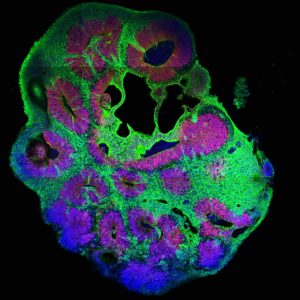A new tissue screening technology has been applied to human brain organoids, report scientists at the Austrian Academy of Sciences. The technology, called CRISPR-LICHT (for CRIPSR-LIneage tracing at Cellular resolution in Heterogenous Tissue), was used to determine that 25 out of 173 candidate microencephaly genes are indeed linked to the rare neurological condition, which is characterized by abnormal brain development and reduced head size.
Previously, 27 genes had been implicated in microencephaly. So, with the new finding, the total number of known microencephaly genes has almost doubled.
Besides shedding new light on microencephaly, CRISPR-LICHT demonstrates a CRISPR screening approach that could be applied to other organoids. CRISPR-LICHT, its developers indicate, could simplify the rapid testing of candidate genes for a range of human diseases.
“We are very excited to report that we now can routinely do genetic screens in complex organoid systems,” emphasized Jürgen Knoblich, PhD, scientific director of the Institute of Molecular Biotechnology of the Austrian Academy of Sciences (IMBA). “The method can be applied to other organoid models and to any disease affecting organ formation.”
Knoblich is the senior author of a new study (“A human tissue screen identifies a regulator of ER secretion as a brain size determinant”) that appeared October 29 in the journal Science. The study describes CRISPR-LICHT as a completely new approach to analyzing brain disorders. “[It] bears incredible future potential,” said Knoblich, “as it can be applied to any brain disease, including autism.”
“Pioneered in laboratory animals, loss-of-function (LOF) screens of human genes are currently restricted to two-dimensional (2D) cell culture hindering testing of gene functions requiring tissue context,” the article’s authors wrote. “Here we present CRISPR-LICHT, casenabling parallel LOF studies in human cerebral organoid tissue.”
Human cerebral organoids can recapitulate the disease better than cell cultures or mouse models, but screening for microcephaly genes in three-dimensional tissue structures has been difficult.
“Using our tissue screening approach, we have almost doubled the number of model-verified genes causative for microcephaly,” the authors continued. Specifically, the IMBA scientists showed that “Early Response 3 Interacting Protein 1 (IER3IP1) regulates the unfolded protein response (UPR) and extracellular matrix (ECM) protein secretion crucial for tissue integrity, with dysregulation resulting in microcephaly.”
Many of the fundamental principles in biology and essentially all pathways regulating development were identified in genetic screens. Originally pioneered in the fruit fly Drosophila and the nematode Caenorhabditis elegans, genetic screens involve inactivation of many genes one by one. By analyzing the consequences of gene loss, scientists can draw conclusions about its function. This way, for example, all genes required for formation of a brain can be identified.
Genetic screens can routinely be carried out in flies and worms. In humans, a wealth of knowledge exists about genetic disorders and the consequences of disease-relevant mutations, but their systematic analysis was impossible. Now, with the CRISPR-LICHT technique, the Knoblich lab has shown that CRISPR screening can allow hundreds of genes to be analyzed in parallel in human tissue.
“The basis of the technique is a combination of the well-known CRISPR-Cas9 technology … and a dual-barcoding method,” detailed Dominik Lindenhofer, a PhD student at IMBA and co-first author of the current study. “The key trick was to apply a guide RNA, but also a genetic barcode, a piece of DNA that we add to the genome of the cells we use to grow organoids.

“This allows us to see the entire cell lineage of each organoid, while a second barcode lets us to count the number of cells generated by each starting cell. This reduces noise and so we can determine the effect of each guide RNA on the number of cells produced during organoid growth.”
“Not only were we able to identify microcephaly genes with CRISPR-LICHT, but we also pinpointed a specific mechanism involved in controlling the size of the brain,” stressed IMBA postdoc and co-first author Christopher Esk. In this mechanism, the endoplasmic reticulum serves a control element in the secretion of extracellular matrix protein. When the mechanism fails, tissue integrity suffers, affecting brain size and contributing to microcephaly.


